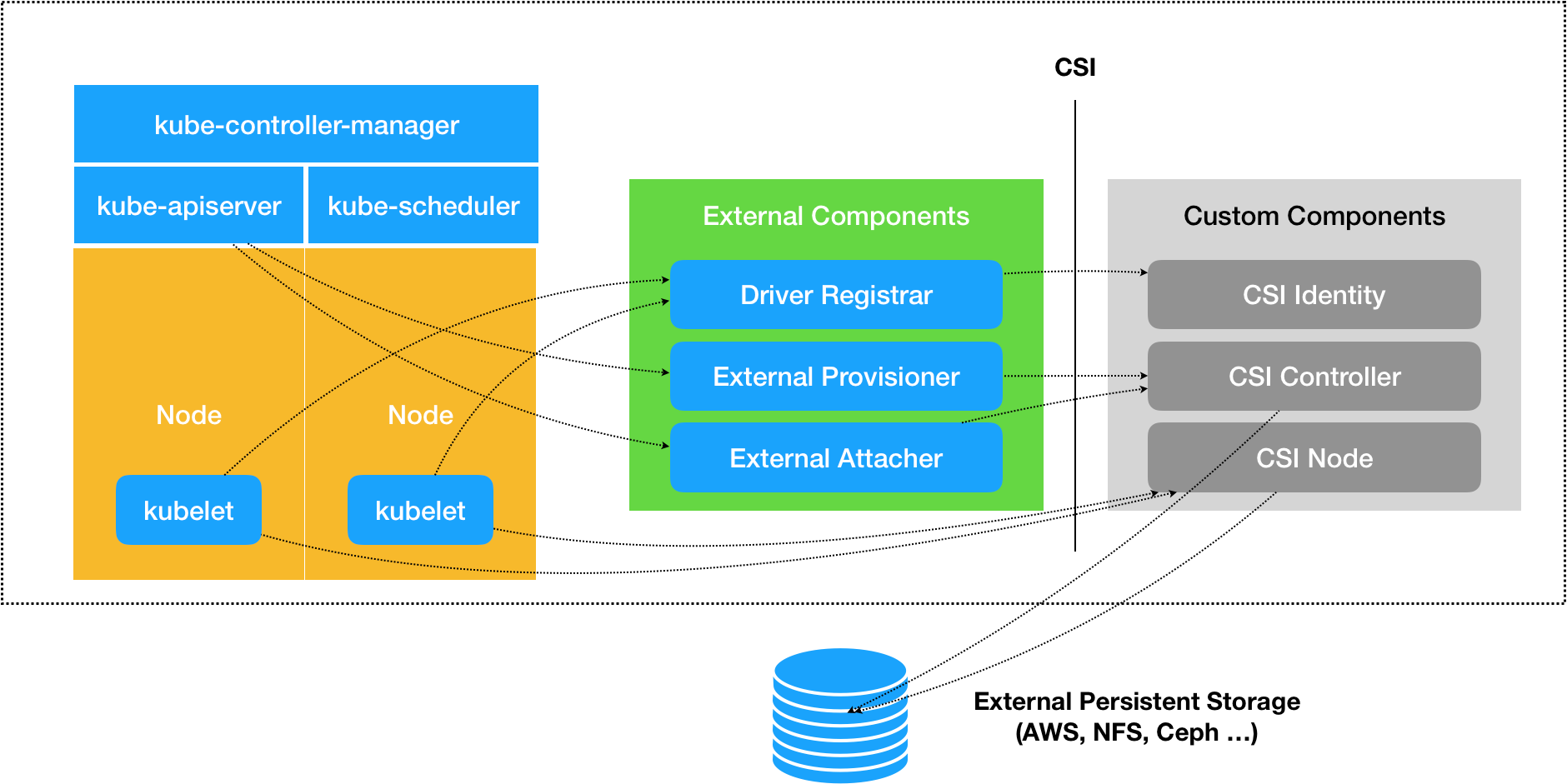kubernetes CSI
目录:
CSI
存储插件开发有两种方式,分别是FlexVolume和CSI
FlexVolume
示例一个FlexVolume的yaml
apiVersion: v1
kind: PersistentVolume
metadata:
name: pv-flex-nfs
spec:
capacity:
storage: 10Gi
accessModes:
- ReadWriteMany
flexVolume:
driver: "k8s/nfs"
fsType: "nfs"
options:
server: "10.10.0.25" # 改成你自己的NFS服务器地址
share: "export"
这里指定了
- driver为k8s/nfs
- fsType为nfs
一个pv被创建了之后,在被pvc绑定之后,就会进入两阶段处理Attach和Mount
示例Mount通过SetUpAt()方法完成
// SetUpAt creates new directory.
func (f *flexVolumeMounter) SetUpAt(dir string, fsGroup *int64) error {
...
call := f.plugin.NewDriverCall(mountCmd)
// Interface parameters
call.Append(dir)
extraOptions := make(map[string]string)
// pod metadata
extraOptions[optionKeyPodName] = f.podName
extraOptions[optionKeyPodNamespace] = f.podNamespace
...
call.AppendSpec(f.spec, f.plugin.host, extraOptions)
_, err = call.Run()
...
return nil
}
以上配置就会调用以下命令
/usr/libexec/kubernetes/kubelet-plugins/volume/exec/k8s~nfs/nfs mount <mount dir> <json param>
- k8s~nfs为driver的k8s/nfs转义
- nfs为fsType
- mount为固定的操作参数,有init、mount、unmount、attach和dettach等
为传递过来的参数,为Volume在宿主机上的目录,默认在 /var/lib/kubelet/pods/<Pod ID>/volumes/k8s~nfs/test是一个jsonmap的参数列表,在pv的options定义的值都会被追加到这个参数,并包含一个PodName和PodNamespace等数据
这个nfs命令可以通过脚本的方式完成
domount() {
MNTPATH=$1
NFS_SERVER=$(echo $2 | jq -r '.server')
SHARE=$(echo $2 | jq -r '.share')
...
mkdir -p ${MNTPATH} &> /dev/null
mount -t nfs ${NFS_SERVER}:/${SHARE} ${MNTPATH} &> /dev/null
if [ $? -ne 0 ]; then
err "{ \"status\": \"Failure\", \"message\": \"Failed to mount ${NFS_SERVER}:${SHARE} at ${MNTPATH}\"}"
exit 1
fi
log '{"status": "Success"}'
exit 0
}
这个返回的结果需要返给kubelet来判断是否完成的标准
详细例子
在FlexVolume架构下,存储插件为volume的Attach阶段和Mount阶段的执行者,而没有管理管理的功能
CSI
对于nfs这种文件系统,并不需要在宿主机上挂载磁盘或者块设备,就不需要attach和dettach的操作了,而且FlexVolume也不支持Dynamic Provisioning,除非再单独写一个External Provisioner
CSI是将Dynamic Provision和部分管理功能拆出来,作为一个External Components,需要的功能有Driver Registrar、External Provisioner和External Attacher

一个CSI的插件需要提供这三个grpc服务
- Driver Registrar负责将插件注册到kubelet,所以需要请求CSI的Identity服务
- External Provisioner负责Provision,watch了APIServer的PVC对象,当PVC创建的时候会调用CSI Controller的CreateVolume方法去创建PV,不过不会使用kubernetes的PV类型,而是单独定义一个Volume类型
- External Attacher负责Attach阶段,watch了APIServer的VolumeAttachment变化,一旦有新增的VolumeAttachment,就会调用ControllerPublish方法来指定对应的Attach
volume的Mount阶段是在kubelet的VolumeManagerReconciler循环检测到需要执行Mount操作的时候,通过pkg/volume/csi包调用CSI Node服务完成Mount阶段
CSI Identity服务,用于暴露插件本身的信息,接口如下:(以下参考CSI接口代码)
service Identity {
// return the version and name of the plugin
rpc GetPluginInfo(GetPluginInfoRequest)
returns (GetPluginInfoResponse) {}
// reports whether the plugin has the ability of serving the Controller interface
rpc GetPluginCapabilities(GetPluginCapabilitiesRequest)
returns (GetPluginCapabilitiesResponse) {}
// called by the CO just to check whether the plugin is running or not
rpc Probe (ProbeRequest)
returns (ProbeResponse) {}
}
CSI Controller服务
- 创建和删除CSI Volume
- 对CSI Volume进行Attach/Dettach(在CSI里,这个操作被叫作Publish/Unpublish),以及对CSI Volume进行Snapshot
接口如下
service Controller {
// provisions a volume
rpc CreateVolume (CreateVolumeRequest)
returns (CreateVolumeResponse) {}
// deletes a previously provisioned volume
rpc DeleteVolume (DeleteVolumeRequest)
returns (DeleteVolumeResponse) {}
// make a volume available on some required node
rpc ControllerPublishVolume (ControllerPublishVolumeRequest)
returns (ControllerPublishVolumeResponse) {}
// make a volume un-available on some required node
rpc ControllerUnpublishVolume (ControllerUnpublishVolumeRequest)
returns (ControllerUnpublishVolumeResponse) {}
...
// make a snapshot
rpc CreateSnapshot (CreateSnapshotRequest)
returns (CreateSnapshotResponse) {}
// Delete a given snapshot
rpc DeleteSnapshot (DeleteSnapshotRequest)
returns (DeleteSnapshotResponse) {}
...
}
这些逻辑都不需要在宿主机完成
CSI Node服务用于宿主机执行对应操作,接口如下
service Node {
// temporarily mount the volume to a staging path
rpc NodeStageVolume (NodeStageVolumeRequest)
returns (NodeStageVolumeResponse) {}
// unmount the volume from staging path
rpc NodeUnstageVolume (NodeUnstageVolumeRequest)
returns (NodeUnstageVolumeResponse) {}
// mount the volume from staging to target path
rpc NodePublishVolume (NodePublishVolumeRequest)
returns (NodePublishVolumeResponse) {}
// unmount the volume from staging path
rpc NodeUnpublishVolume (NodeUnpublishVolumeRequest)
returns (NodeUnpublishVolumeResponse) {}
// stats for the volume
rpc NodeGetVolumeStats (NodeGetVolumeStatsRequest)
returns (NodeGetVolumeStatsResponse) {}
...
// Similar to NodeGetId
rpc NodeGetInfo (NodeGetInfoRequest)
returns (NodeGetInfoResponse) {}
}
FlexVolume和CSI的区别
FlexVolume只有两个阶段
- Mount
- Attach
而CSI有三个阶段
- Provision
- Attach
- Mount
Provision阶段将会watch apiserver中PVC资源的创建,如果PVC所指定的storageClass的provisioner是自身。将会调用插件的controller.createVolume()创建PV
Attach阶段将会watch apiserver中VolumeAttachment对象变化, 会调用插件的controller.ControllerPublish(),把相应的磁盘attach到声明使用此PVC/PV的pod所调度到的node上,挂载的目录为/var/lib/kubelet/pods/
Mount阶段,kubelet的VolumeManagerReconciler控制循环,检测到需要执行Mount操作的时候,通过调用pkg/volume/csi包,调用CSI Node服务,调用CRI启动带有volume参数的container,把上阶段准备好的磁盘 mount到container指定的目录
CSI编写指南
示例StorageClass
kind: StorageClass
apiVersion: storage.k8s.io/v1
metadata:
name: do-block-storage
namespace: kube-system
annotations:
storageclass.kubernetes.io/is-default-class: "true"
provisioner: com.digitalocean.csi.dobs
这里指定的provisioner=com.digitalocean.csi.dobs,就是指定的CSI插件
CSI插件代码结构
$ tree $GOPATH/src/github.com/digitalocean/csi-digitalocean/driver
├── controller.go
├── driver.go
├── identity.go
├── mounter.go
└── node.go
在driver.go中定义标准的grpc服务
// Run starts the CSI plugin by communication over the given endpoint
func (d *Driver) Run() error {
...
listener, err := net.Listen(u.Scheme, addr)
...
d.srv = grpc.NewServer(grpc.UnaryInterceptor(errHandler))
csi.RegisterIdentityServer(d.srv, d)
csi.RegisterControllerServer(d.srv, d)
csi.RegisterNodeServer(d.srv, d)
d.ready = true // we're now ready to go!
...
return d.srv.Serve(listener)
}
将接口注册到grpc服务上即可
示例用于注册到k8s的GetPluginInfo
func (d *Driver) GetPluginInfo(ctx context.Context, req *csi.GetPluginInfoRequest) (*csi.GetPluginInfoResponse, error) {
resp := &csi.GetPluginInfoResponse{
Name: driverName,
VendorVersion: version,
}
...
}
这个driver就是com.digitalocean.csi.dobs,要满足反向dns格式
GetPluginCapabilities返回的CSI的能力,例如NFS不需要Provision和Attach阶段,因为直接挂载到container的目录即可
还有一个Probe接口,用来检查CSI是否正常工作,一般建议在编写插件的时候设置一个Ready标志,当gRPC服务停止的时候,将其设置为false
Provision阶段对应的接口为CreateVolume和DeleteVolume,调用者为External Provisoner
示例
func (d *Driver) CreateVolume(ctx context.Context, req *csi.CreateVolumeRequest) (*csi.CreateVolumeResponse, error) {
...
volumeReq := &godo.VolumeCreateRequest{
Region: d.region,
Name: volumeName,
Description: createdByDO,
SizeGigaBytes: size / GB,
}
...
vol, _, err := d.doClient.Storage.CreateVolume(ctx, volumeReq)
...
resp := &csi.CreateVolumeResponse{
Volume: &csi.Volume{
Id: vol.ID,
CapacityBytes: size,
AccessibleTopology: []*csi.Topology{
{
Segments: map[string]string{
"region": d.region,
},
},
},
},
}
return resp, nil
}
对于DigitalOcean这样的公有云,就是调用DigitalOcean的API来创建一个存储卷
Attach阶段对应的接口为ControllerPublishVolume和ControllerUnpublishVolume,调用者为External Attacher
示例ControllerPublishVolume
func (d *Driver) ControllerPublishVolume(ctx context.Context, req *csi.ControllerPublishVolumeRequest) (*csi.ControllerPublishVolumeResponse, error) {
...
dropletID, err := strconv.Atoi(req.NodeId)
// check if volume exist before trying to attach it
_, resp, err := d.doClient.Storage.GetVolume(ctx, req.VolumeId)
...
// check if droplet exist before trying to attach the volume to the droplet
_, resp, err = d.doClient.Droplets.Get(ctx, dropletID)
...
action, resp, err := d.doClient.StorageActions.Attach(ctx, req.VolumeId, dropletID)
...
if action != nil {
ll.Info("waiting until volume is attached")
if err := d.waitAction(ctx, req.VolumeId, action.ID); err != nil {
return nil, err
}
}
ll.Info("volume is attached")
return &csi.ControllerPublishVolumeResponse{}, nil
}
对于DigitalOcean来说,就是调用DigitalOcean的API,将之前创建的存储卷挂载到指定的虚拟机上,存储卷为之前创建的时候指定的VolumeId,虚拟机就是NodeId
External Attacher进行VolumeAttachment对象的watch
// VolumeAttachmentSpec is the specification of a VolumeAttachment request.
type VolumeAttachmentSpec struct {
// Attacher indicates the name of the volume driver that MUST handle this
// request. This is the name returned by GetPluginName().
Attacher string
// Source represents the volume that should be attached.
Source VolumeAttachmentSource
// The node that the volume should be attached to.
NodeName string
}
分别是
- 存储插件的名字(Attacher)
- PV的名字(Source)
- 宿主机的名字(NodeName)
这个对象的声明周期是由AttachDetachController负责,不断检测Pod所对应的PV在宿主机上的挂载情况,来决定是否需要Attach或Dettach
Mount阶段是在CSI Node服务,代码在node.go
细分就两个接口NodeStageVolume和NodePublishVolume
在kubelet的VolumeManagerReconciler中,这两步对应着MountDevice和Setup
MountDevice(NodeStageVolume)格式化Volume在宿主机的存储设备,然后挂载到一个临时目录(Staging目录)
func (d *Driver) NodeStageVolume(ctx context.Context, req *csi.NodeStageVolumeRequest) (*csi.NodeStageVolumeResponse, error) {
...
vol, resp, err := d.doClient.Storage.GetVolume(ctx, req.VolumeId)
...
source := getDiskSource(vol.Name)
target := req.StagingTargetPath
...
if !formatted {
ll.Info("formatting the volume for staging")
if err := d.mounter.Format(source, fsType); err != nil {
return nil, status.Error(codes.Internal, err.Error())
}
} else {
ll.Info("source device is already formatted")
}
...
if !mounted {
if err := d.mounter.Mount(source, target, fsType, options...); err != nil {
return nil, status.Error(codes.Internal, err.Error())
}
} else {
ll.Info("source device is already mounted to the target path")
}
...
return &csi.NodeStageVolumeResponse{}, nil
}
流程就是找到对应设备挂载路径getDiskSource,格式化为d.mounter.Format格式,然后挂载到临时目录StagingTargetPath下
SetUp(NodePublishVolume)的实现
func (d *Driver) NodePublishVolume(ctx context.Context, req *csi.NodePublishVolumeRequest) (*csi.NodePublishVolumeResponse, error) {
...
source := req.StagingTargetPath
target := req.TargetPath
mnt := req.VolumeCapability.GetMount()
options := mnt.MountFlag
...
if !mounted {
ll.Info("mounting the volume")
if err := d.mounter.Mount(source, target, fsType, options...); err != nil {
return nil, status.Error(codes.Internal, err.Error())
}
} else {
ll.Info("volume is already mounted")
}
return &csi.NodePublishVolumeResponse{}, nil
}
将Volume挂载到宿主机目录
对于NFS和GlusterFS没有对应的磁盘设备在宿主机,就在VolumeManagerReconciler循环中,跳过MountDevice直接执行SetUp
这个服务的部署yaml
kind: DaemonSet
apiVersion: apps/v1beta2
metadata:
name: csi-do-node
namespace: kube-system
spec:
selector:
matchLabels:
app: csi-do-node
template:
metadata:
labels:
app: csi-do-node
role: csi-do
spec:
serviceAccount: csi-do-node-sa
hostNetwork: true
containers:
- name: driver-registrar
image: quay.io/k8scsi/driver-registrar:v0.3.0
...
- name: csi-do-plugin
image: digitalocean/do-csi-plugin:v0.2.0
args :
- "--endpoint=$(CSI_ENDPOINT)"
- "--token=$(DIGITALOCEAN_ACCESS_TOKEN)"
- "--url=$(DIGITALOCEAN_API_URL)"
env:
- name: CSI_ENDPOINT
value: unix:///csi/csi.sock
- name: DIGITALOCEAN_API_URL
value: https://api.digitalocean.com/
- name: DIGITALOCEAN_ACCESS_TOKEN
valueFrom:
secretKeyRef:
name: digitalocean
key: access-token
imagePullPolicy: "Always"
securityContext:
privileged: true
capabilities:
add: ["SYS_ADMIN"]
allowPrivilegeEscalation: true
volumeMounts:
- name: plugin-dir
mountPath: /csi
- name: pods-mount-dir
mountPath: /var/lib/kubelet
mountPropagation: "Bidirectional"
- name: device-dir
mountPath: /dev
volumes:
- name: plugin-dir
hostPath:
path: /var/lib/kubelet/plugins/com.digitalocean.csi.dobs
type: DirectoryOrCreate
- name: pods-mount-dir
hostPath:
path: /var/lib/kubelet
type: Directory
- name: device-dir
hostPath:
path: /dev
---
kind: StatefulSet
apiVersion: apps/v1beta1
metadata:
name: csi-do-controller
namespace: kube-system
spec:
serviceName: "csi-do"
replicas: 1
template:
metadata:
labels:
app: csi-do-controller
role: csi-do
spec:
serviceAccount: csi-do-controller-sa
containers:
- name: csi-provisioner
image: quay.io/k8scsi/csi-provisioner:v0.3.0
...
- name: csi-attacher
image: quay.io/k8scsi/csi-attacher:v0.3.0
...
- name: csi-do-plugin
image: digitalocean/do-csi-plugin:v0.2.0
args :
- "--endpoint=$(CSI_ENDPOINT)"
- "--token=$(DIGITALOCEAN_ACCESS_TOKEN)"
- "--url=$(DIGITALOCEAN_API_URL)"
env:
- name: CSI_ENDPOINT
value: unix:///var/lib/csi/sockets/pluginproxy/csi.sock
- name: DIGITALOCEAN_API_URL
value: https://api.digitalocean.com/
- name: DIGITALOCEAN_ACCESS_TOKEN
valueFrom:
secretKeyRef:
name: digitalocean
key: access-token
imagePullPolicy: "Always"
volumeMounts:
- name: socket-dir
mountPath: /var/lib/csi/sockets/pluginproxy/
volumes:
- name: socket-dir
emptyDir: {}
DaemonSet部署的是每个节点都启动的
- csi-do-plugin: 为kubelet提供CSI的Node和Identity服务,由于Mount阶段都是使用的MountNamespace,对于kubelet都是/var/lib/kubelet下的目录,需要挂载这个目录
- driver-registrar:用于向kubelet注册CSI插件,数据是访问csi-do-plugin的Identity服务得到的
需要注意的是mountPropagation=Bidirectional,即开启双向挂载传播,从而将容器在这个目录下进行的挂载操作传播给宿主机
StatefulSet部署的是CSI Controller,提供External Provisioner和External Attacher,这里StatefulSet是为了保证Pod删除之后才会创建和启动
创建的PVC指定storageClass即可
apiVersion: v1
kind: PersistentVolumeClaim
metadata:
name: csi-pvc
spec:
accessModes:
- ReadWriteOnce
resources:
requests:
storage: 5Gi
storageClassName: do-block-storage
总结一下流程
- 当创建了一个PVC之后,StatefulSet里的External Provisioner容器,就会监听到这个PVC的诞生,然后调用同一个Pod里的CSI插件的CSI Controller服务的CreateVolume方法,创建出对应的PV
- Volume Controller,就会通过PersistentVolumeController控制循环,发现这对新创建出来的PV和PVC,并且看到它们声明的是同一个StorageClass。会把这一对PV和PVC绑定起来,使PVC进入Bound 状态
- 当创建了一个声明使用上述PVC的Pod,并且这个Pod被调度器调度到了宿主机A上。这时候,Volume Controller的AttachDetachController控制循环就会发现,上述 PVC对应的Volume,需要被Attach到宿主机 A 上。AttachDetachController会创建一个VolumeAttachment对象,这个对象携带了宿主机A和待处理的Volume的名字
- StatefulSet里的External Attacher容器,就会监听到这个VolumeAttachment对象的诞生,使用这个对象里的宿主机和Volume名字,调用同一个Pod里的CSI插件的CSI Controller 服务的 ControllerPublishVolume方法,完成Attach
- 宿主机 A 上的 kubelet,就会通过VolumeManagerReconciler控制循环,发现当前宿主机上有一个Volume对应的存储设备(比如磁盘)已经被Attach到了某个设备目录下,就会调用同一台宿主机上的CSI插件的CSI Node服务的NodeStageVolume和NodePublishVolume方法,完成这个Volume的Mount阶段
需要注意的点是
- PVC不会限制PV的使用,只是用于绑定PV,用于Pod使用
- PV也不会限制存储的使用,只要后端存储能写就可以
- 对于StorageClass,在申请Pv的时候是能获取到申请的大小,提供存储的服务支持划分大小就可以做到限制,例如ceph等,不能的例如nfs

